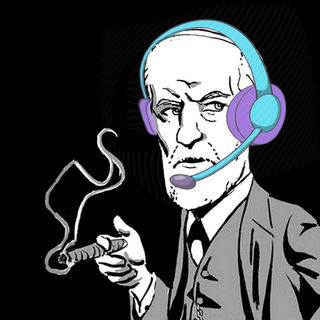Online Therapy
My Advice After Doing Phone Therapy for 20 Years
Therapy by phone: YES! Therapy by video: NO!
Posted May 1, 2020 Reviewed by Hara Estroff Marano

If you are a therapist, you might be frustrated that sheltering in place has forced you to do teletherapy instead of seeing patients in your office. That’s how I felt 20 years ago when I first started doing teletherapy. But I wouldn’t have it any other way now.
Twenty years ago, I had a thriving private psychoanalytic practice in Los Angeles. Although I am trained as a psychoanalyst, I rarely used a couch and almost always worked with patients face to face.
But when my wife’s mother was diagnosed with Lewy body dementia, we moved to a different state and everything changed. Lewy body dementia is a cross between dementia and Parkinson’s disease. We’d never heard of it before, but it had resulted in my mother-in-law believing an imaginary family was living in her house.
Fortunately, she was happy--unlike Robin Williams, who also had Lewy body dementia. She did not become agitated, anxious or dull as might be expected with dementia. My wife’s mom was delighted to have an imaginary family living with her. She would set places at the table for each member of the imaginary family and put children’s shows on the TV for the imaginary children to watch.
Within weeks of the diagnosis, my wife closed down her successful criminal defense practice, and I informed my patients about the situation and that I would need to work with them by phone. In record time, we moved to a beautiful but rural part of the coast of Oregon, where my wife’s mom lived, so that we could help take care of her.
While the idea of doing therapy by phone was strange and frightening to me, my suitemate in Los Angeles was a very experienced supervisor and grad-school instructor who assured me that it was not only possible but that I might find it works well. I shouldn’t have doubted him!
During the past 20 years I have worked with a number of new patients by phone—people who I have never sat face to face with in an office.
Tuning in When Hearing as Opposed to Seeing
What I soon discovered is that working by phone allowed me to tune in to parts of patients’ psyches that I hadn’t realized was possible. When you are sitting in an office together, you aren’t as aware of the subtle shifts in tone and of breath sounds that you are when working by phone. These subtle changes can communicate far more than you can take in with your eyes.
Fortunately, working on the phone wasn’t as big a problem for my patients as I had worried it would be. I think they were actually relieved to not have to fight Los Angeles traffic to get to my office. But I also made changes in the way I worked-—so my therapy by phone wasn’t simply an audio version of therapy in person.
I’ll discuss some of those changes, as well as my advice about the different types of headsets and phone equipment I’ve tried over the years. SPOILER ALERT: After constant frustrations with the $250 binaural headset and pre-amp I’d purchased from an online company that specializes in headsets, I now use a $19 ATT phone that I bought at Walmart, and it works just fine!
HIPAA Compliance and State Requirements
Each state has different requirements for teletherapy, so please check the requirements in the state in which you are licensed. Also, the company that arranges teletherapy for veterans in the western states requires that therapists use a video setup that I find to be toxic. Actually, I find this entire company that the VA has contracted with to be toxic. As a result, I regrettablyy do not do teletherapy with vets, who might benefit from working with a therapist who has 30 years of experience. But if you do work with vets, make sure you are using the kind of system the VA requires.
Why I So Dislike Doing Therapy with Video vs the Phone
Video therapy was not an option 20 years ago, and I’m glad it wasn’t. I’ve found that therapy by phone helps provide a window into a patient’s deeper self, where therapy by FaceTime, Skype, Zoom or the expensive HIPPA-compliant video services becomes all about the camera. It’s like watching a really bad YouTube video filmed on a hand-held phone or having to teach classes by Zoom.
The one exception might be therapy with a patient who has early object-relations deficits and needs to take you in visually, the way an infant takes in a mother’s gaze. However, given how one-dimensional therapy by video looks, I’m not sure it will soothe that kind of patient, and it may make them feel even more deprived or disconnected. This is something you and your patients will need to discuss if it’s an issue for them. Perhaps by understanding more about their experience of what’s missing, you will be able to make as much progress as if you were meeting face to face.
Even if your patients don’t have such early object-relations deficits, it’s important to hear their concerns about working remotely, if they have them. And the last thing a therapist should ever do is complain to a patient about any discomfort the therapist might have about working remotely.
Creating a Safe Space by Phone
For those of you who practice depth or psychodynamic therapy, you’ve probably studied the importance of creating a safe place or “frame” for each patient. This is one of the reasons why so many of us have agonized over every piece of furniture, object, and wall hanging in our offices. We want our offices to be a symbol of the safe space or frame we hope to create with our patients—a place where they can bring their chaos, rage, sadness, happiness, joy, or dozens of other feelings that they don’t feel safe having with the other people in their lives.
You now need to create this kind of safe space with your voice—but please, don’t think this means going overboard and exaggerating your laughs or your comforting sighs. You accomplish this with your presence and with your intense interest in what the patient is saying. Trust me, you’ll get the hang of this!
When you are doing therapy in person, a smile can communicate approval or acceptance. When working by phone, it’s your voice that communicates such things. Again, you will find subtle but powerful ways of communicating these qualities.
Reassuring Sounds
When working by phone, you might find it helpful to make occasional low-key and brief verbal sounds-—more than you would during an in-person session. This helps to let the patient know you are fully present, as opposed to their fears that you might be reading your texts and emails. But you want to be attuned to when you are crossing an invisible line where the sounds you make interrupt a patient’s thought processes.
The Urge to Read Your Messages
If you do find yourself wanting to read your texts or emails, ask yourself if there’s something your patient might be avoiding or feels uncomfortable saying to you, or if there are feelings of deadness or chaos that your patient is trying to communicate. Monitor your own emotions during teletherapy just as you do during in-person session. Just be aware that the urge to check your messages during a phone session could be similar to when you feel like dozing off during an in-person session. It’s an important communication from you to yourself that something’s going on that you need to pay attention to.
How to Avoid Becoming Overly Friendly or Too Familiar
A colleague who has never done phone therapy until now has said he’s concerned he might respond to patients more like he responds to friends when he’s on the phone or on FaceTime. I’ve never found this to be a concern, because I regard my phone sessions as being very different from my casual communications with friends, all the way down to the chair I use.
I sit in a very specific chair in a specific quiet place, and I don’t have to worry about interruptions. The only time I sit in that chair is when I’m doing therapy or reading journal articles or writing something that is therapy-related. I’ve also made sure that my therapy chair is in a part of my home that is private.
As for how I dress, I would never do phone therapy in a robe or pajamas, assuming I had a robe and pajamas. But I don’t feel a need to dress better during teletherapy. For me, jeans and a tee shirt are fine, even if I would never wear these to an in-person therapy session. But if you find it helps to dress as you would for an in-person session, by all means do.
Just make sure the space you work in at home is different from where you do your video gaming or watch Netflix, Hulu, or PornHub. You need to create in your mind an office that is its own separate space.
Dealing with Chaos and Nonverbal Issues
After 20 years of doing supervision with grad students and therapists, I always try to be alert to when therapists make interpretations or suggestions before understanding what a patient is actually saying or needing. That’s because those of us who become therapists often have a need to fix things, which is fine, but not if you aren’t sure what it is a patient needs your help in fixing.
Most of us understand that if patients had the right words for what they were feeling—or, in some cases, knew what they were feeling—they probably wouldn’t need to be in therapy to begin with! So a central part of being a therapist is asking patients to explain what they mean. This is particularly important when dealing with feelings that don’t have words, such as chaos and preverbal issues, and emotions that have been hidden away in remote parts of the mind.
Fortunately, working by phone can be a great way of doing psychodynamic therapy. Being able to hear the different tones, pauses, and breath sounds provides a wealth of data about the interpersonal world of the patient. Working by phone can create a situation where patients are more likely to freely associate than if they were sitting across from you and trying to read your expressions and body language to gauge your approval.
Equipment: Beware the Noise-Cancelling Mic
If you decide to use a professional headset, you will also need to get a pre-amp, since headsets usually don’t provide enough sound amplification on their own. You’ll also find that some headsets have microphones and others come with voice tubes. Whether the headset has a voice tube or a mic, be sure it is NOT noise-cancelling.
Noise-cancelling headsets were designed to be used in busy call centers, where there’s lots of ambient noise. They block out the noise that’s around you. However, in the process, they can’t help but remove some of the frequencies of your voice, or at least that’s been my experience. So if you decide to get a headset, don’t just order it online. Speak to someone at the online store that sells headsets and tell them you are using the headset for therapy as opposed to being in a busy office. Explain how it’s important that your voice is transmitted clearly, and since you are in a quiet office, you don’t need a mic or voice tube that cancels out or filters ambient sounds.
If you are using earbuds and a mic, be sure to test it with friends. Tell them it’s important that your voice sound natural and full. And make sure that when you move, the mic doesn’t brush against your clothes and make an annoying sound for the listener. Also be sure you can hear the other person’s voice clearly. The sound quality of the incoming voice is as important as the sound quality of the outgoing voice.
My Phone Setup—Before and After Our Beagle Ate It
I originally assumed I would be able to do better phone therapy if I was using a hands-free set that I could wear on my head like stereo headphones. These headsets have a voice tube that you speak into.
I can’t tell you how relieved I was after our beagle chewed up my first headphone setup. After finding what had become the most expensive chew toy in history, I made a quick dash to the nearest Walmart to buy an inexpensive hand-held phone.
Shock of all shocks, the $19 ATT phone I got from Walmart worked better for me than the $250 hands-free job I’d purchased after doing days of research. I’ve since tried another headset and pre-amp, this one costing even more, and I still ended up going back to the $19 phone from Walmart. But your situation might be different.
Landline vs Cell—Important Considerations
We live in a remote part of the coast of Oregon, with poor cell service and internet service that’s only somewhat better than dial-up. So I do phone therapy over a landline instead of a cellular network, because the last thing I want is a patient having to deal with a bad connection on my end. Also, when we lose power during storms, landlines usually still work.
As for the all-too-familiar situation of dropped or garbled words when a patient is using a cellphone, don’t suffer in silence. You need to let them know when the connection gets bad. If this is a constant problem, talk to them about it. Maybe there’s a place they can sit where the connection is better or turn in a different direction. I’ve also found that a patient sometimes accidentally holds their phone with a finger over the mic. You need to let them know.
I Have Them Call Me
When I first started doing phone therapy, I would call patients for our sessions. But since I use a landline, the cost in long-distance charges can be nasty. So I now have patients phone me for sessions, given that I don’t charge nearly as much for sessions as many of my colleagues do. Also, most of my patients have unlimited calling with their cellphones, a feature not available on my landline.
You Will Be Fine!
Although I was forced into doing teletherapy, it has worked incredibly well, I owe a big debt of gratitude to my mother-in-law. If she hadn’t gotten Lewy body dementia, I would never have given therapy by phone a chance.




